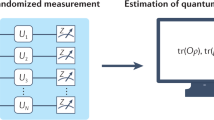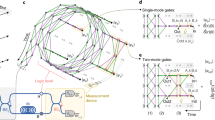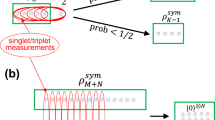Abstract
Standard quantum computation is based on sequences of unitary quantum logic gates that process qubits. The one-way quantum computer proposed by Raussendorf and Briegel is entirely different. It has changed our understanding of the requirements for quantum computation and more generally how we think about quantum physics. This new model requires qubits to be initialized in a highly entangled cluster state. From this point, the quantum computation proceeds by a sequence of single-qubit measurements with classical feedforward of their outcomes. Because of the essential role of measurement, a one-way quantum computer is irreversible. In the one-way quantum computer, the order and choices of measurements determine the algorithm computed. We have experimentally realized four-qubit cluster states encoded into the polarization state of four photons. We characterize the quantum state fully by implementing experimental four-qubit quantum state tomography. Using this cluster state, we demonstrate the feasibility of one-way quantum computing through a universal set of one- and two-qubit operations. Finally, our implementation of Grover's search algorithm demonstrates that one-way quantum computation is ideally suited for such tasks.
This is a preview of subscription content, access via your institution
Access options
Subscribe to this journal
Receive 51 print issues and online access
$199.00 per year
only $3.90 per issue
Buy this article
- Purchase on Springer Link
- Instant access to full article PDF
Prices may be subject to local taxes which are calculated during checkout






Similar content being viewed by others
References
Deutsch, D. & Ekert, E. Quantum computation. Phys. World 11, 47–52 (1998)
Braunstein, S. L. & Lo, H.-K. (eds) Experimental proposals for quantum computation. Fortschr. Phys. 48 (special focus issue 9–11), 767–1138 (2000).
Shor, P. W. in Proc. 35th Annu. Symp. Foundations of Computer Science (ed. Goldwasser, S.) 124–134 (IEEE Computer Society Press, Los Alamitos, 1994)
Grover, L. K. Quantum mechanics helps in search for a needle in a haystack. Phys. Rev. Lett. 79, 325–328 (1997)
Bennett, C. & DiVicenzo, D. Quantum information and computation. Nature 404, 247–255 (2000)
Ekert, A. & Josza, R. Quantum algorithms: entanglement enhanced information processing. Phil. Trans. R. Soc. Lond. A 356, 1769–1782 (1998)
Gottesman, D. & Chuang, I. L. Demonstrating the viability of universal quantum computation using teleportation and single-qubit operations. Nature 402, 390–393 (1999)
Knill, E., Laflamme, R. & Milburn, G. J. A scheme for efficient quantum computation with linear optics. Nature 409, 46–52 (2001)
Linden, N. & Popescu, S. Good dynamics versus bad kinematics: Is entanglement needed for quantum computation? Phys. Rev. Lett. 87, 047901 (2001)
Josza, R. & Linden, N. On the role of the entanglement in quantum computational speed-up. Proc. R. Soc. Lond. A 459, 2011–2032 (2003)
Nielsen, M. A. Quantum computation by measurement and quantum memory. Phys. Lett. A 308, 96–100 (2003)
Biham, E., Brassard, G., Kenigsberg, D. & Mor, T. Quantum computing without entanglement. Theor. Comput. Sci. 320, 15–33 (2004)
Briegel, H. J. & Raussendorf, R. Persistent entanglement in arrays of interacting particles. Phys. Rev. Lett. 86, 910–913 (2001)
Raussendorf, R. & Briegel, H. J. A one-way quantum computer. Phys. Rev. Lett. 86, 5188–5191 (2001)
Raussendorf, R. & Briegel, H. J. Computational model underlying the one-way quantum computer. Quant. Inform. Comput. 2, 344–386 (2002)
Raussendorf, R., Brown, D. E. & Briegel, H. J. The one-way quantum computer—a non-network model of quantum computation. J. Mod. Opt. 49, 1299–1306 (2002)
Raussendorf, R., Brown, D. E. & Briegel, H. J. Measurement-based quantum computation on cluster states. Phys. Rev. A 68, 022312 (2003)
Nielsen, M. & Dawson, C. M. Fault-tolerant quantum computation with cluster states. Preprint at http://arXiv.org/quant-ph/0405134 (2004).
Mandel, O. et al. Controlled collisions for multiparticle entanglement of optically trapped ions. Nature 425, 937–940 (2003)
O'Brien, J. L., Pryde, G. J., White, A. G., Ralph, T. C. & Branning, D. Demonstration of an all-optical quantum controlled-not gate. Nature 426, 264–267 (2003)
Pittman, T. B., Fitch, M. J., Jacobs, B. C. & Franson, J. D. Experimental controlled-not logic gate of single photons in the coincidence basis. Phys. Rev. A. 68, 032316 (2003)
Gasparoni, S., Pan, J.-W., Walther, P., Rudolph, T. & Zeilinger, A. Realization of a photonic controlled-NOT gate sufficient for quantum computation. Phys. Rev. Lett. 92, 020504 (2004)
Sanaka, K., Jennewein, T., Pan, J.-W., Resch, K. & Zeilinger, A. Experimental nonlinear sign-shift for linear optics quantum computation. Phys. Rev. Lett. 92, 017902 (2004)
Nielsen, M. A. Optical quantum computation using cluster states. Phys. Rev. Lett. 93, 040503 (2004)
Brown, D. E. & Rudolph, T. Efficient linear optical quantum computation. Preprint at http://arXiv.org/quant-ph/0405157 (2004).
Walther, P. et al. De Broglie wavelength of a non-local four-photon state. Nature 429, 158–161 (2004)
Hein, M., Eisert, J. & Briegel, H.-J. Multi-party entanglement in graph states. Phys. Rev. A 69, 062311 (2004)
Roos, C. F. et al. Control and measurement of three-qubit entangled states. Science 304, 1478–1480 (2004)
Weinstein, Y. et al. Quantum process tomography of the quantum Fourier transform. J. Chem. Phys. 121, 6117–6133 (2004)
Hradil, Z. Quantum-state estimation. Phys. Rev. A 55, R1561–R1564 (1997)
Banaszek, K., Ariano, A., Paris, M. & Sacchi, M. Maximum-likelihood estimation of the density matrix. Phys. Rev. A 61, 010304 (1999)
James, D., Kwiat, P., Munro, W. & White, A. Measurement of qubits. Phys. Rev. A 64, 052312 (2001)
Toth, G. & Guehne, O. Detecting genuine multipartite entanglement with two local measurements. Preprint at http://arXiv.org/quant-ph/0405165 (2004).
Dür, W. & Briegel, H.-J. Stability of macroscopic entanglement under decoherence. Phys. Rev. Lett. 92, 180403 (2004)
Greenberger, D. M., Horne, M. A. & Zeilinger, A. in Bell's Theorem, Quantum Theory and Concepts of the Universe (ed. Kafatos, M.) (Kluwer, Dordrecht, 1989)
Zeilinger, A., Horne, M. & Greenberger, D. in Squeezed States and Quantum Uncertainty (eds Han, D., Kim, Y. S. & Zachary, W. W.) (NASA Conference Publication 3135, NASA, College Park, 1992)
Dür, W., Vidal, G. & Cirac, J. I. Three qubits can be entangled in two inequivalent ways. Phys. Rev. A 62, 62314–62325 (2000)
SenDe, A., Sen, U., Wiesniak, M., Kaszlikowski, D. & Zukowski, M. Multi-qubit W states lead to stronger nonclassicality than Greenberger-Horne-Zeilinger states. Phys. Rev. A 68, 623306 (2003)
Horodecki, M., Horodecki, P. & Horodecki, R. Separability of mixed states: necessary and sufficient conditions. Phys. Lett. A 223, 1–8 (1996)
Peres, A. Separability criterion for density matrices. Phys. Rev. Lett. 77, 1413–1415 (1996)
Chuang, I. L. & Nielsen, M. A. Prescription for experimental determination of the dynamics of a quantum black box. J. Mod. Opt. 44, 2455–2467 (1997)
Poyatos, J. F., Cirac, J. I. & Zoller, P. Complete characterization of a quantum process: the two-bit quantum gate. Phys. Rev. Lett. 78, 390–393 (1997)
Schumacher, B. Quantum coding. Phys. Rev. A 51, 2738–2747 (1995)
Coffman, V., Kundu, J. & Wootters, W. K. Distributed entanglement. Phys. Rev. A 61, 052306 (2000)
Horodecki, R., Horodecki, P. & Horodecki, M. Violating Bell inequality by mixed spin-1/2 states: necessary and sufficient condition. Phys. Lett. A 200, 340–344 (1995)
Ahn, J., Weinacht, T. C. & Bucksbaum, P. H. Information storage and retrieval through quantum phase. Science 287, 463–465 (2000)
Bhattacharya, N., van Linden van den Heuvell, H. B. & Spreeuw, R. J. C. Implementation of quantum search algorithm using classical Fourier optics. Phys. Rev. Lett. 88, 137901 (2002)
Chuang, I. L., Gershenfeld, N. & Kubinec, M. Experimental implementation of a fast quantum searching. Phys. Rev. Lett. 80, 3408–3411 (1997)
Jones, J. A., Mosca, M. & Hansen, R. H. Implementation of a quantum search algorithm on a quantum computer. Nature 393, 344–346 (1998)
Kwiat, P. G. et al. New high-intensity source of polarization-entangled photon pairs. Phys. Rev. Lett. 75, 4337–4342 (1995)
Acknowledgements
We thank H. J. Briegel, D. Browne and M. Zukowski for theoretical discussions, and C. Först for assistance with graphics. This work was supported by the Austrian Science Foundation (FWF), NSERC, the European Commission under project RAMBOQ, and by the Alexander von Humboldt Foundation.
Author information
Authors and Affiliations
Corresponding authors
Ethics declarations
Competing interests
The authors declare that they have no competing financial interests.
Supplementary information
Supplementary Tables 1-2
The state fidelities of the output qubits from one-qubit and two-qubit quantum computations. (DOC 189 kb)
Rights and permissions
About this article
Cite this article
Walther, P., Resch, K., Rudolph, T. et al. Experimental one-way quantum computing. Nature 434, 169–176 (2005). https://doi.org/10.1038/nature03347
Received:
Accepted:
Issue Date:
DOI: https://doi.org/10.1038/nature03347
This article is cited by
-
Purcell-enhanced single photons at telecom wavelengths from a quantum dot in a photonic crystal cavity
Scientific Reports (2024)
-
Quantifying Entanglement by Purity in a Cavity-Magnon System
Brazilian Journal of Physics (2024)
-
Strong second-harmonic generation by sublattice polarization in non-uniformly strained monolayer graphene
Nature Communications (2023)
-
Cavity-enhanced single-shot readout of a quantum dot spin within 3 nanoseconds
Nature Communications (2023)
-
A chip-scale polarization-spatial-momentum quantum SWAP gate in silicon nanophotonics
Nature Photonics (2023)
Comments
By submitting a comment you agree to abide by our Terms and Community Guidelines. If you find something abusive or that does not comply with our terms or guidelines please flag it as inappropriate.



